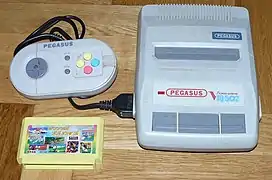Pegasus (console)
Pegasus is a video game system by Micro Genius. It is a Nintendo Entertainment System hardware clone of the Nintendo Famicom (Japanese original model of the Nintendo Entertainment System) that was sold in Poland, Serbia, Bosnia and Herzegovina and the Czech Republic during the early to mid 1990s.[3]
| Type | Video game console |
|---|---|
| Release date |
|
| Discontinued | 1997[2] |
| Media | ROM cartridge |
| CPU | 1.779 MHz 8-bit MOS 6502 |
Hardware
| Processor | UMC UA6527P or similar clone of 8-bit MOS 6502 1,77 MHz | |
| Video | Chip | UMC UA6528P or similar clone |
| Clock | 5.37 MHz | |
| Resolution | 256×240 | |
| Colour palette | 25 on screen (out of 64 possible) | |
| Standard | PAL, 50 Hz refresh rate | |
| Sound | 5-channel mono | 1 channel noise 1 PCM 3 channels for sounds External audio source via cartridge pins 48 and 49 |
| Media | ROM cartridge, floppy disk (if equipped with the FDS) (Nintendo 60-pin equivalent) | |
History
The system was manufactured in Taiwan by Micro Genius, and built to resemble Nintendo Famicom. Pegasus, like most known NES clones, was compatible with 60-pin Famicom cartridges, and partially compatible with some NES games, which could be played using a special converter. Genuine Nintendo games were not commonly available however, due to widespread piracy and the lack of officially licensed products on the market. The majority of the games sold with and for the system were cheap unlicensed copies, manufactured mostly in Russia and China.
The typical retail set included the system, two detachable gamepads (both with "turbo" buttons, which meant 4 buttons in total; 6-button controllers also existed.), a light gun (very similar in design to NES Zapper), power supply, RF cable, as well as audio-video RCA connectors. The system itself did not include any built-in games, but was bundled with an infringing cartridge labelled "Contra 168-in-1", which contained a few of the best-known NES titles, such as Contra, Super Mario Bros., and Tetris, listed multiple times with slight variations. Most of the games had a "trainer" feature, which allowed the player to adjust the number of lives, and even the starting level of the game.
The 8-bit Pegasus was originally released in two versions: MT777DX and the IQ-502 with rounded casing, controller ports on the sides of the system and an eject button instead of a lever, both manufactured by Micro Genius). There was also a later 16-bit version known as "Power Pegasus 16-bit", a Sega Mega Drive clone. There was also a rare version of the console called Pegasus Game Boy released in 1993 which was a clone of Game Boy.[4]
This particular Famiclone was popular in Poland, Serbia, and Bosnia, where it gained cult status, and was widely available at flea markets. In some countries, clones from this brand have been created on which can play NES cartridges. An example is Indonesia where Spica Club sold such models.[5]
See also
- Dendy
- Ending-Man Terminator
References
- "Elektronik z meliorantem". pb.pl.
- "Gambler Magzine (March 1998) : Free Download, Borrow, and Streaming : Internet Archive". Internet Archive. 2020-06-10. Retrieved 2020-12-05.
- "Dejte mi jedno Polystation, pane stánkař". Hrej.cz.
- "Data" (JPG). i.imgur.com. Retrieved 2020-12-05.
- "Archived copy". Archived from the original on 2019-08-08. Retrieved 2019-08-08.CS1 maint: archived copy as title (link)
External links
- EMU-NES, a Polish website about Pegasus and similar systems
- Cartridges/carts gallery
- History of famiclones in Poland
| Wikimedia Commons has media related to Famicom/NES unlicensed hardware clones. |
